EXCELLENT RESULTS FROM THE 2022 HARVEST, BUT WHAT NEXT?

With the harvest safely gathered in Jeff Claydon, Suffolk arable farmer and inventor of the Opti-Till® direct strip seeding system, discusses the results and looks ahead to next season.

18 August 2022
It has been a very strange year for weather in most parts of the UK. Here in Suffolk, where annual rainfall is just 600mm making it one of the driest regions, the exceptional conditions brought back memories of 1976. That year, almost no rain fell between March and September and during a visit to the county then Minister of Agriculture, the late Fred Peart, described the drought as a tragedy, urging the public not to panic. Sounds familiar! Between New Year’s day and the end of May this year our farm weather station recorded 196.8mm of rain, well below the long-term average. April brought only 18.6mm and in May 41.6mm fell, followed by 34.4mm in June and a miniscule 10.4mm in July, contributing to a total of just 244mm for the year to date. Much of that came in the form of short, localised showers, so the water evaporated very quickly and produced little benefit.
One positive of the exceptionally dry conditions was our earliest-ever harvest. The 12m Claas Lexion 600 Terra-Trac had an uninterrupted run from the time we cut the first oilseed rape in mid-July until the last spring oats which were combined during the first week of August. With daytime temperatures consistently in the mid-to-high 30s and little in the way of overnight dew we were able keep going for as long as we were physical able to do so. It was a very tiring couple of weeks, but with help from my sons, Oliver and Spencer, harvest was completed in record time and with wheat coming into store at 11-12% there were no drying costs.
Too dry to drill
The downside of the prolonged dry weather is that currently the land is too dry to drill oilseed rape. Normally, the crop would have been in the ground a week or two ago but, with no moisture to start the germination process, drilling it then would have been a mistake. Patience is the key as we await some meaningful rain! The ground is so dry and cracked that undertaking any form of conventional cultivations would be very expensive in fuel, excess wear on machinery and ground-engaging metal. Breaking down the large clods created by that approach would also be very time-consuming and expensive but driving around the area those drawbacks have not stopped some from trying. On our own heavy clay land, the Claydon Straw Harrow has been successfully deployed across the whole farm, the main limitation being keeping dust to a minimum by restricting forward speed when operating close to houses in the village, especially if they have washing on the line!
With our rotation having changed from wheat and oilseed rape to include more spring-sown and break crops, the aim is to use land destined for spring drilling to help reduce the weed burden and seed bank using Opti-Till® stubble management techniques which move no more than 2cm of topsoil. This enables us to control weed seeds and volunteers without herbicides, other than one full-rate application of glyphosate just prior to drilling. Effective stubble management has become particularly important following the loss of neonicotinoid seed treatments and some products to control grassweeds due to the inherent fear that the aphid vectors of Barley Yellow Dwarf Virus (BYDV) will increase significantly. However, BYVD can be reduced considerably by using the Opti-Till® system to manage stubbles and eliminate the ‘green bridge’ effect. It also enables drilling to be delayed, but to do that with any degree of certainty you must be able to get the crop in the ground quickly, which means not having too many operations before sowing.
Last night’s 2.4mm of rain was just enough to make conditions perfect for the Claydon Straw Harrow, a simple, robust, fast, and very effective stubble management tool with many uses. Operating at 15 – 25km/h, it is equipped with sprung steel tines which vibrate rapidly to break up straw and expose chopped crop residues. They also create a ‘boiling’ action which uproots weeds and volunteers, as well as destroying slugs and slug eggs. An additional upside of the hot, dry conditions has been that slugs have had a very tough time and have been unable to breed, so we will not have to worry about them this season.
The Straw Harrow creates a fine micro-tilth in the top 20- 30mm of soil, providing ideal conditions for rapid germination of weeds and volunteers, which can then be raked out and destroyed with another pass before they become established. When glyphosate is eventually applied, it is as a single, full strength dose prior to drilling, which maximises its effectiveness and reduces the risk of weed resistance Even during a prolonged dry spell and high summer temperatures the difference between harrowed and unharrowed soil is clear. Unharrowed soil is hard and baked with shrinkage cracks; soil that has been harrowed has a crumbly, fine tilth and crop residues have been broken into small pieces.
20-Year Anniversary
This harvest marked 20 years of establishing all crops on the farm using only Claydon Opti-Till® products. These consist of the Straw Harrow, occasionally the TerraStar® light rotary cultivator where slightly more soil movement is required, together with the Claydon direct strip seeding drill, followed by the TerraBlade inter-row hoe. My last article for Direct Driller mentioned that our crops were showing exciting potential, and they certainly lived up to expectations. That was a pleasant surprise given the lack of rain and the fact that we backed off on the nitrogen due to concerns that it would not be fully utilised in the dry conditions. This was a good decision, made easier because we only grow feed wheats. Winter wheats received 190kgN/ha, 50 – 60kgN/ ha less than our normal 240-250kgN/ha, and oilseed rape a similar amount, again less than normal.
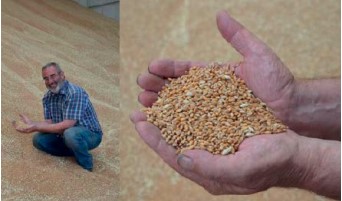
In a couple of small areas where nitrogen was missed when applying it through our 36m self-propelled sprayer, for which I can only blame myself, the yield plummeted, highlighting the importance of this major nutrient. Without fertiliser and agchems yields would quickly regress to 1970s levels, around 30cwt for barley and 2 tons per acre in ‘old money’ terms, or 3.7t/ha and 5t/ha respective in modern parlance. The key difference between the 1970s and now is that there are more mouths to feed. According to the Office of National Statistics the UK population was 56,226,000 in 1975, it rose to 65,110,000 in 2015 and is projected to hit 69,444,000 by 2025. Should we therefore be concerned about the dramatic curbs on nitrogen use currently being proposed by the governments of The Netherlands and Canada?
Fungicide programmes were maintained at normal levels because these products more than cover their cost through increased yield. Past experience has shown that if yellow rust or other foliar diseases take hold significant yield potential has already been lost by the time the signs become visible, far outweighing the cost of an effective treatment programme..
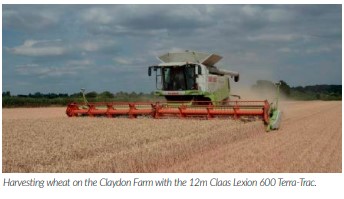
Good drainage increases yields
Drainage is very important to get the best from our heavy clay soils and in a couple of areas where the old tile system had broken down a significant reduction in yield was apparent. One 12ha area produced 7.78t/ha, compared with over 9.5t/ha in the adjacent field, an overall loss across that small area of around 25 tonnes, so correcting the problem was a priority. Dry weather allowed local drainage contractor W. R. Suckling & Sons to install new plastic pipes 1m deep across a total of 40ha in various fields. Some was done in the spring, some through rape stubble, and we will mole drain across these areas when conditions allow. Land is far too valuable to have it underperform, and this investment should maximise its potential by increasing yields.
The dry spring and summer, combined with the use of a Claydon TerraBlade inter-row hoe meant that our crops were the cleanest I have ever known, with no spring-germinated blackgrass. I am delighted with the results of the 2022 harvest, high yields underlining the benefits of establishing deep rooting structures which enabled crops to make best use of available moisture. Having recently invested in a new weighbridge we know that the yield information is precise and have posted it on the Claydon website (claydondrill.com). Those of you who have visited the Claydon factory will know the 16ha field to the right of the access road. The winter wheat there yielded just over 10t/ha, while the average across our whole IACA registered area was 9.54t/ha, with higher-thanaverage hectolitre weights. Given the lack of rain and 25% reduction in nitrogen use those are both excellent figures.
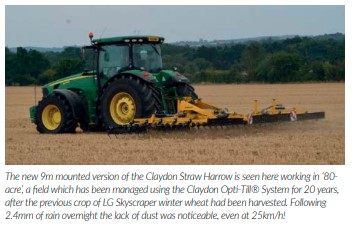
Hybrid oilseed rape provided a similarly pleasing result. DK Excited, which was drilled at just 2.7kg/ha using a preproduction version of our new Claydon Evolution drill, averaged 3.84t/ha, with one field producing 4.2t/ha. Given that the crop had to contend with very dry weather, some pigeon damage, and small areas where cabbage stem flea beetle had attacked, these yields are exceptional. With very low establishment costs, a low level of fungicide use, and just 190kgN/ha the margin will be very attractive. Spring oats put in a surprising performance and are destined for use in a range of gluten-free products such as breakfast cereals and oat milk. We drilled the new Elsoms variety Lion directly into stubble which had been Straw Harrowed using a seed rate of just 100kg/ha and the crop subsequently received a total of 100kgN/ha in two equal splits.
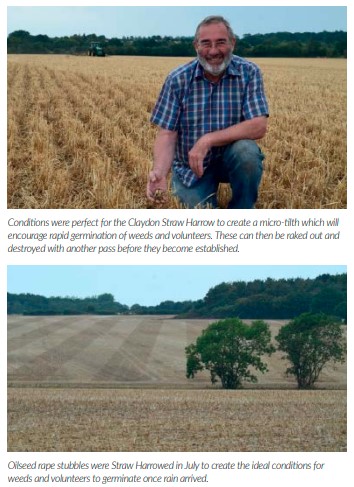
A Claydon TerraBlade inter-row hoe took out any grassweeds growing between the band-sown rows before they had a chance to develop and compete with the spring oats, so the crop looked clean throughout. Given the season’s challenges I was very pleased that it averaged 6.11t/ha, which was slightly below the 7t/ha from last year’s crop of WPB Elyann (KWS) but that had much more favourable growing conditions. We will be drilling Lion again in 2023, as 25% of the farm will be into spring oats, 25% oilseed rape and 50% winter wheat, all first wheats.
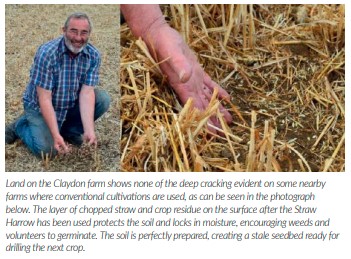
Current conditions are the polar opposite of those last year, when there was plenty of moisture in the ground during August, but September was quite dry. With the ground currently bone dry we are waiting for significant rainfall to provide some moisture, so everything is currently in a state of limbo. The soil temperature is much higher than at the same time last year, so I am not too concerned that oilseed rape has not been drilled; it is much better to wait and sow into moisture than have the seed sit there doing nothing. Our own land is showing none of the deep cracking which is evident on some nearby farms where conventional cultivations and establishment protocols are used, nor do we have deep tramlines which will take time and money to put right. In contrast, our, fields are level with a layer of fine tilth and crop residues on the surface which will protect and insulate the soil, providing perfect conditions for drilling when we do get some rain.

With Claydon customers saving up to £250/ha on establishment costs by using the Opti-Till® System demand for our products from farmers throughout the world is at record levels, so I am delighted that our new 36m x 36m clear-span building is almost finished. We have managed the build project in-house but, due to difficulties in getting contractors, progress has been slower than anticipated. The concern now is finding enough additional staff to fill the numerous vacancies that we have to offer so if you know of anyone who might be interested in a role please ask them to contact us! When complete the new facility will double our production capacity.
Just before harvest, accredited master thatcher Harry Roberts of Harry Roberts Thatching Services finished replacing the roof at Gaines Hall, our Grade II listed 16th Century farmhouse. After 44 years’ service it was rethatched using wheat straw grown by Harry using the heritage wheat variety Maris Widgeon, drilled using a Claydon drill. We are delighted with the results.